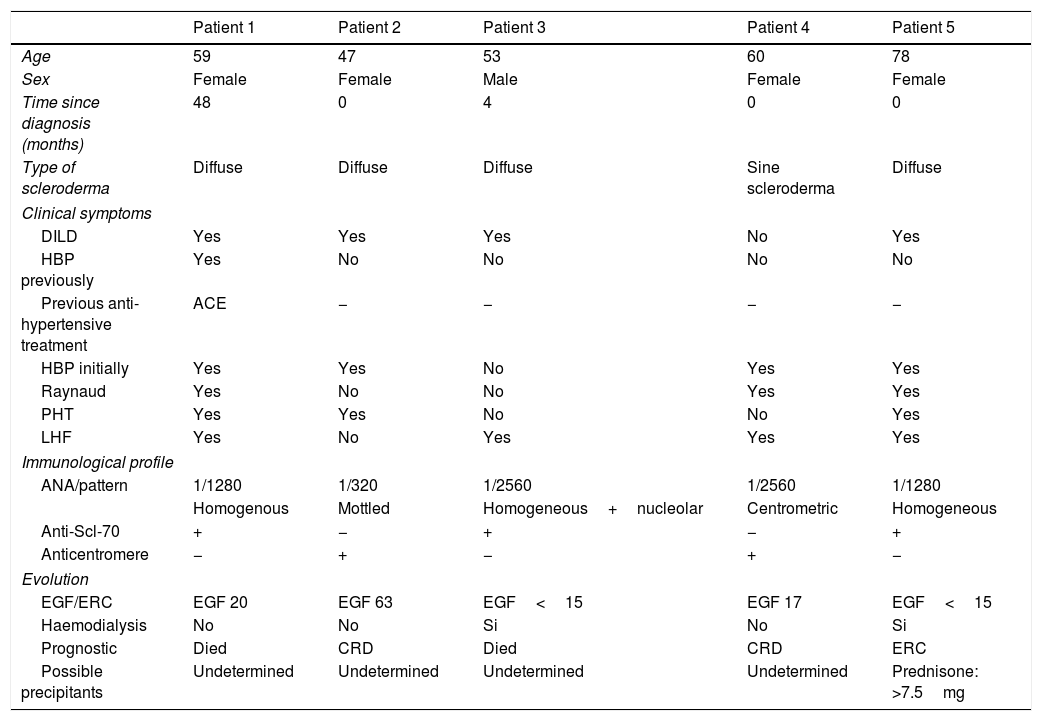Systemic sclerosis (SS) scleroderma is a systemic autoimmune disease with excessive deposits of collagen, vascular lesions, inflammation, fibrosis of the skin and of different internal organs.1–3
The severest renal involvement is the scleroderma renal crisis (SRC), a rare complication with a prevalence of 4%–6%: 7%–9% diffuse SS and .5%–.6% limited form SS.4
In SRC new onset accelerated high blood pressure occurs, and rapid progression oliguric renal failure in the context of SS. Between 11% and 14%, of patients have normal blood pressure levels.2,3,5,6
We present a series of 5 cases of SRC who were cared for in our hospital and describe the main clinical characteristics, immunological profile, and disease evolution.
Five cases were identified out of a total of 150 patients diagnosed with SS in the University Hospital Central de Asturias from 2000 until 2017. Their characteristics are contained in Table 1. Diagnosis of SRC was made in according with the criteria proposed by Penn et al. in 2007.
Characteristics and evolution of the 5 patients with Scleroderma Renal Crisis.
| Patient 1 | Patient 2 | Patient 3 | Patient 4 | Patient 5 | |
|---|---|---|---|---|---|
| Age | 59 | 47 | 53 | 60 | 78 |
| Sex | Female | Female | Male | Female | Female |
| Time since diagnosis (months) | 48 | 0 | 4 | 0 | 0 |
| Type of scleroderma | Diffuse | Diffuse | Diffuse | Sine scleroderma | Diffuse |
| Clinical symptoms | |||||
| DILD | Yes | Yes | Yes | No | Yes |
| HBP previously | Yes | No | No | No | No |
| Previous anti-hypertensive treatment | ACE | − | − | − | − |
| HBP initially | Yes | Yes | No | Yes | Yes |
| Raynaud | Yes | No | No | Yes | Yes |
| PHT | Yes | Yes | No | No | Yes |
| LHF | Yes | No | Yes | Yes | Yes |
| Immunological profile | |||||
| ANA/pattern | 1/1280 | 1/320 | 1/2560 | 1/2560 | 1/1280 |
| Homogenous | Mottled | Homogeneous+nucleolar | Centrometric | Homogeneous | |
| Anti-Scl-70 | + | − | + | − | + |
| Anticentromere | − | + | − | + | − |
| Evolution | |||||
| EGF/ERC | EGF 20 | EGF 63 | EGF<15 | EGF 17 | EGF<15 |
| Haemodialysis | No | No | Si | No | Si |
| Prognostic | Died | CRD | Died | CRD | ERC |
| Possible precipitants | Undetermined | Undetermined | Undetermined | Undetermined | Prednisone: >7.5mg |
ANA: antinuclear antibodies; DILD: diffuse interstitial lung disease; CRD: chronic renal; FGE: estimated glomerular filtration; HBP: high blood pressure; PHT: pulmonary hypertension; ICI: left heart failure; ACE: angiotensin converting enzyme inhibitors; Scl-70: anti-topoisomerase antibodies.
Determination of antinuclear antibodies (ANA), anti-topoisomerase (Scl-70) and anticentromere antibodies were made using immunofluorescence.
Of the 5 cases there were 4 diffuse SS and one SS sine scleroderma. Eighty per cent were women with a median age of 59 years. In 3 patients diagnosis of SS was established with the initiation of SRC and in 2 cases this occurred between the first signs of SS and the diagnosis of SRC was at 3 and 48 months, respectively. In one case BP values were normal, the others presented with accelerated high blood pressure. One hundred per cent had renal failure. In the immunological study the ANA were positive in 5 patients. The Scl-70 were positive in 3 patients and in 2 the anticentromere was positive.
One case required diagnostic renal biopsy. Forty per cent required haemodialysis; 2 died. During the SRC they all received treatment with the angiotensin-converting enzyme inhibitors (ACE).
SRC is a potentially mortal complication with a prevalence of 3.3% in our hospital, more frequently at the start of the diffuse forms, and is able to present on diagnosis, as occurred in 3 patients of our series where the SRC was diagnosed from SS.
Risk factors predicting SRC have been described as: anemia, recent cardiac involvement, anti-RNA polimerase III antibodies and the use of corticoids (>15–20mg/day).1,2,5 In the majority of our patients no possible trigger was identified. One of our patients had been in treatment with corticoids at doses above 7.5mg/day.
There are no data to show that pre-existing factors such as high blood pressure, proteinuria, raised creatinine levels, anti Scl-70, anticentromere antibody, or previous histological renal changes are associated with a higher frequency in the development of the SRC.2
Morbimortality by SRC is high and difficult to manage. It is a medical emergency, initially focused on BP control. ACEi are the drugs of choice, even in patients with renal failure. There is controversy regarding its prophylactic use as previous treatment with ACEi prior to the diagnosis of SRC may obscure its presentation.7
Dual therapy: ACEi and the endothelin inhibitor (bosentan) have been used in a series of 6 patients, with a follow-up of 5 months with improvement of glomerular filtration, with no changes in mortality and without studies to endorse its safety.7 Sixty per cent of patients will require renal replacement therapy.2,6
When there are signs of accelerated blood pressure with oliguric renal failure sometimes accompanied by thrombotic microangiopathy of unexplained causes and cardiological involvement (pericarditis, cardiac blockage) we must direct out investigations to the diagnosis of an SS, usually diffuse, since SRC is a treatable complication if there is early identification.
Please cite this article as: Andrade López AC, Bande Fernández JJ, Colunga Argüelles D, Gómez de la Torre R. Crisis renal esclerodérmica: la experiencia de un hospital de tercer nivel. Reumatol Clin. 2020;16:306–307.







